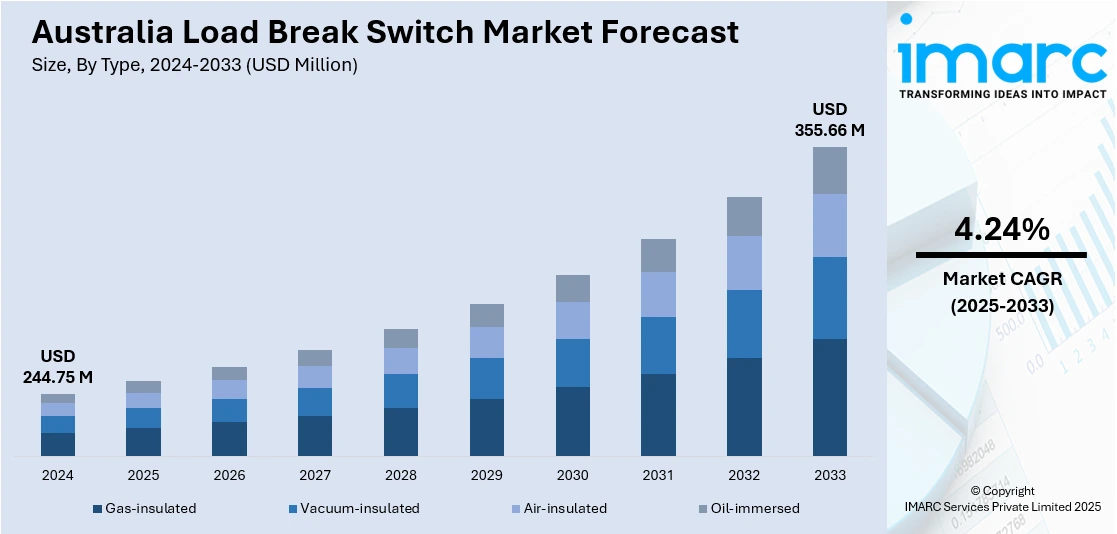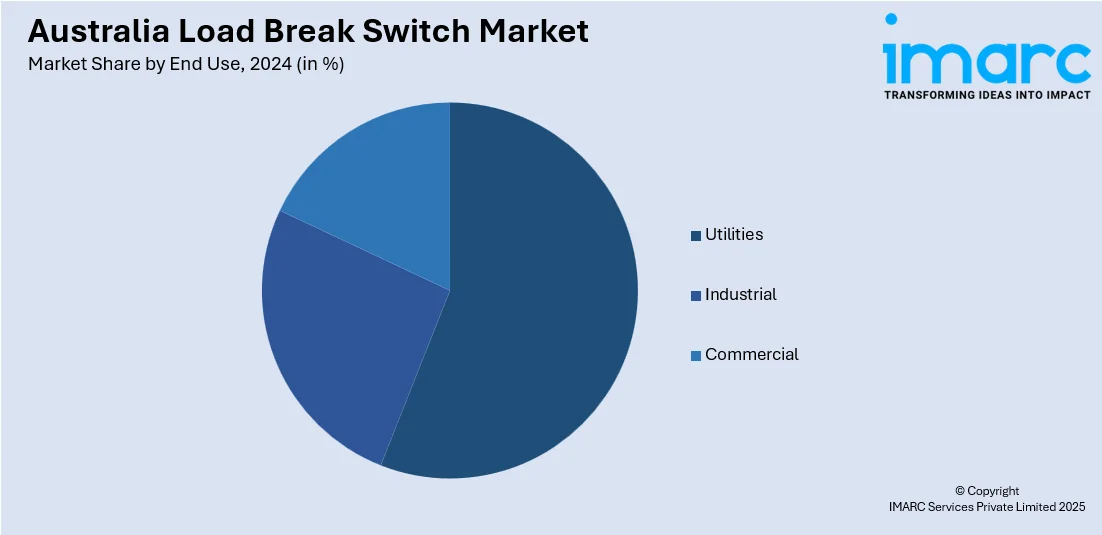
Australia Load Break Switch Market Size, Share, Trends and Forecast by Type, Voltage, Installation, End Use, and Region, 2025-2033
Australia Load Break Switch Market Overview:
The Australia Load Break Switch Market size reached USD 244.75 Million in 2024. Looking forward, IMARC Group expects the market to reach USD 355.66 Million by 2033, exhibiting a growth rate (CAGR) of 4.24% during 2025-2033. The market is driven by increasing renewable energy adoption, growing urban infrastructure, and the modernization of aging electrical grids. As the country transitions to cleaner energy sources, there is a rising need for reliable switchgear to manage variable power inputs. Simultaneously, urban expansion demands efficient, safe power distribution. Technological advancements, including automation and remote control features, further support the shift toward smarter, more resilient grid systems, positioning load break switches as essential components in evolving energy infrastructure thus aiding the Australia Load Break Switch Market share.
|
Report Attribute
|
Key Statistics
|
|---|---|
|
Base Year
|
2024
|
|
Forecast Years
|
2025-2033
|
|
Historical Years
|
2019-2024
|
| Market Size in 2024 | USD 244.75 Million |
| Market Forecast in 2033 | USD 355.66 Million |
| Market Growth Rate 2025-2033 | 4.24% |
Australia Load Break Switch Market Trends:
Infrastructure Upgrades and Urbanization
Australia's urban growth and necessity to upgrade inefficient old electrical systems are among the main drivers for load break switch demand. New commercial, industrial, and residential construction demands safe and reliable power distribution solutions, and load break switches serve to satisfy this demand by providing stable and flexible network operation. As urban centers expand and rural districts get increasingly networked, energy infrastructure needs to adapt to carry increased loads and more intricate grids. Australia load break switch market trends reflect this shift toward modernization and resilience in power systems. Upgrading with newer switchgear replaces aging equipment to provide increased safety, fewer outages, and greater efficiency in maintenance. Where districts are being redeveloped, load break switches facilitate unbroken delivery of energy and reduce service interruptions during building construction or changes to the network. They also serve a vital function in enhancing the grid's resilience, especially in regions that are subject to severe weather or other environmental vulnerabilities, and are critical to infrastructure restoration initiatives.

To get more information on this market, Request Sample
Renewable Energy Integration and Grid Modernization
Australia’s transition to renewable energy is gaining momentum, with renewables contributing 39.4% to the national electricity supply in 2023, up from 35% in 2022. This shift to solar, wind, and other clean sources is transforming the national power grid, driving the need for modern infrastructure capable of managing variable and decentralized energy generation. Load break switches play a vital role in this transformation by enabling safe energy transfer, isolating faults, and maintaining grid stability. As utilities move away from conventional power plants, they are investing in smart technologies that support two-way power flow and integrate distributed energy resources. These switches are essential for ensuring reliable service, especially in remote areas and microgrids. With Australia targeting even higher renewable shares by 2030, load break switches are critical tools for creating a flexible, efficient, and future-ready energy network.
Technological Advancements and Smart Grid Adoption
The transition towards intelligent electrical networks is propelling the Australia load break switch market growth in high-end load break switches. New LBS products currently feature automation, remote control, and real-time monitoring. These advancements improve grid stability and facilitate easier fault detection, maintenance, and quick response to outages. With utilities shifting from manual operations, smart switches enable quicker decision-making and streamlined operations. Integration with digital platforms and IoT networks provides predictive maintenance, minimizing downtime and the cost of operations. This shift facilitates a smarter, more responsive, and sustainable grid. For a large nation such as Australia, with often great distances between substations, remote control of switchgear provides obvious operational advantages. These developments place load break switches at the forefront of a future-proof, technology-integrated power infrastructure.
Australia Load Break Switch Market Segmentation:
IMARC Group provides an analysis of the key trends in each segment of the market, along with forecasts at the country and regional levels for 2025-2033. Our report has categorized the market based on type, voltage, installation, and end use.
Type Insights:
- Gas-insulated
- Vacuum-insulated
- Air-insulated
- Oil-immersed
The report has provided a detailed breakup and analysis of the market based on the type. This includes gas-insulated, vacuum-insulated, air-insulated, and oil-immersed.
Voltage Insights:
- Below 11 kV
- 11-33 kV
- 33-60 kV
A detailed breakup and analysis of the market based on the voltage have also been provided in the report. This includes below 11 kV, 11-33 kV, and 33-60 kV.
Installation Insights:
- Outdoor
- Indoor
The report has provided a detailed breakup and analysis of the market based on the installation. This includes outdoor and indoor.
End Use Insights:

- Utilities
- Industrial
- Commercial
A detailed breakup and analysis of the market based on the end use have also been provided in the report. This includes utilities, industrial, and commercial.
Regional Insights:
- Australia Capital Territory & New South Wales
- Victoria & Tasmania
- Queensland
- Northern Territory & Southern Australia
- Western Australia
The report has also provided a comprehensive analysis of all the major regional markets, which include Australia Capital Territory & New South Wales, Victoria & Tasmania, Queensland, Northern Territory & Southern Australia, and Western Australia.
Competitive Landscape:
The market research report has also provided a comprehensive analysis of the competitive landscape. Competitive analysis such as market structure, key player positioning, top winning strategies, competitive dashboard, and company evaluation quadrant has been covered in the report. Also detailed profiles of all major companies have been provided.
Australia Load Break Switch Market News:
- In May 2024, Eaton acquired UK-based Exertherm, a leader in thermal monitoring solutions for electrical equipment. This move enhances Eaton’s capabilities in continuous temperature monitoring, vital for data centers and critical infrastructure. The integration with Eaton’s Brightlayer software will help optimize operations and boost safety. The acquisition supports Eaton’s push toward digitalization and sustainable power management, aligning with global electrification trends and reinforcing its commitment to smarter, greener energy solutions.
Australia Load Break Switch Market Report Coverage:
| Report Features | Details |
|---|---|
| Base Year of the Analysis | 2024 |
| Historical Period | 2019-2024 |
| Forecast Period | 2025-2033 |
| Units | Million USD |
| Scope of the Report |
Exploration of Historical Trends and Market Outlook, Industry Catalysts and Challenges, Segment-Wise Historical and Future Market Assessment:
|
| Types Covered | Gas-insulated, Vacuum-insulated, Air-insulated, Oil-immersed |
| Voltages Covered | Below 11 kV, 11-33 kV, 33-60 kV |
| Installations Covered | Outdoor, Indoor |
| End Uses Covered | Utilities, Industrial, Commercial |
| Regions Covered | Australia Capital Territory & New South Wales, Victoria & Tasmania, Queensland, Northern Territory & Southern Australia, Western Australia |
| Customization Scope | 10% Free Customization |
| Post-Sale Analyst Support | 10-12 Weeks |
| Delivery Format | PDF and Excel through Email (We can also provide the editable version of the report in PPT/Word format on special request) |
Key Questions Answered in This Report:
- How has the Australia load break switch market performed so far and how will it perform in the coming years?
- What is the breakup of the Australia load break switch market on the basis of type?
- What is the breakup of the Australia load break switch market on the basis of voltage?
- What is the breakup of the Australia load break switch market on the basis of installation?
- What is the breakup of the Australia load break switch market on the basis of end use?
- What is the breakup of the Australia load break switch market on the basis of region?
- What are the various stages in the value chain of the Australia load break switch market?
- What are the key driving factors and challenges in the Australia load break switch market?
- What is the structure of the Australia load break switch market and who are the key players?
- What is the degree of competition in the Australia load break switch market?
Key Benefits for Stakeholders:
- IMARC’s industry report offers a comprehensive quantitative analysis of various market segments, historical and current market trends, market forecasts, and dynamics of the Australia load break switch market from 2019-2033.
- The research report provides the latest information on the market drivers, challenges, and opportunities in the Australia load break switch market.
- Porter's five forces analysis assist stakeholders in assessing the impact of new entrants, competitive rivalry, supplier power, buyer power, and the threat of substitution. It helps stakeholders to analyze the level of competition within the Australia load break switch industry and its attractiveness.
- Competitive landscape allows stakeholders to understand their competitive environment and provides an insight into the current positions of key players in the market.
Need more help?
- Speak to our experienced analysts for insights on the current market scenarios.
- Include additional segments and countries to customize the report as per your requirement.
- Gain an unparalleled competitive advantage in your domain by understanding how to utilize the report and positively impacting your operations and revenue.
- For further assistance, please connect with our analysts.
 Request Customization
Request Customization
 Speak to an Analyst
Speak to an Analyst
 Request Brochure
Request Brochure
 Inquire Before Buying
Inquire Before Buying




.webp)




.webp)












